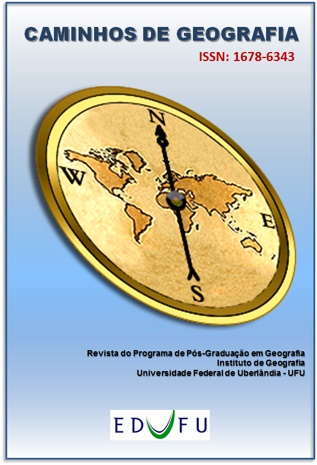USO DE DADOS METEOROLÓGICOS DE REANÁLISE PARA A SIMULAÇÃO DA VAZÃO NA BACIA HIDROGRÁFICA DO RIBEIRÃO DO PINHAL, LIMEIRA/SP
DOI:
https://doi.org/10.14393/RCG228054849Palavras-chave:
SWAT., Modelagem hidrológica., Calibração.Resumo
A grande preocupação com a preservação dos recursos hídricos demanda estudos capazes de avaliar e mitigar os impactos decorrentes das ações antrópicas. O uso de modelos hidrológicos constitui-se numa ferramenta importante, pois permitem simular diferentes cenários e seus impactos na disponibilidade hídrica. No entanto, a complexidade de obter dados meteorológicos observados, torna necessária a utilização de outras fontes de dados. Objetivou-se avaliar se com a utilização de dados meteorológicos de reanálise obtidos do modelo Climate Forecast System Reanalysis (CFSR) é possível calibrar o modelo Soil and Water Assessment Tool (SWAT) e simular a produção de água numa bacia hidrográfica. A área de estudo é a bacia hidrográfica do Ribeirão do Pinhal (BHRP), situada no município de Limeira-SP. Utilizou-se o modelo SWAT para simulação hidrológica com os dados meteorológicos observados e de reanálise. Foi possível calibrar o modelo SWAT utilizando os dados meteorológicos observados e de reanálise. Porém, o ajuste foi melhor quando se utilizou os dados meteorológicos observados. A vazão simulada utilizando dados de reanálise foi superestimada. Os dados meteorológicos de reanálise são adequados para simulações hidrológicas com o modelo SWAT, o que é evidenciado por meio dos índices estatísticos satisfatórios obtidos no procedimento de calibração do modelo SWAT.
Downloads
Downloads
Publicado
Edição
Seção
Licença
Autores que publicam nesta revista concordam com os seguintes termos: a) Autores mantém os direitos autorais e concedem à revista o direito de primeira publicação, com o trabalho licenciado sob a Creative Commons Atribuição-NãoComercial-SemDerivações 4.0 Internacional. b) Autores têm permissão e são estimulados a publicar e distribuir seu trabalho online (ex.: em repositórios institucionais ou na sua página pessoal), já que isso pode gerar alterações produtivas, bem como aumentar o impacto e a citação do trabalho publicado. c) Em virtude de aparecerem nesta revista de acesso público, os artigos são de uso gratuito, com atribuições próprias, em aplicações educacionais e não-comerciais.











